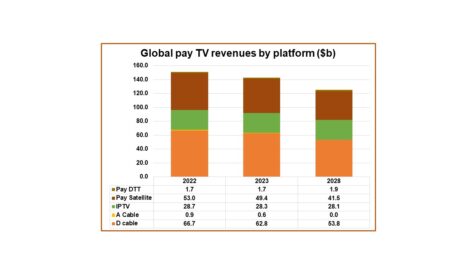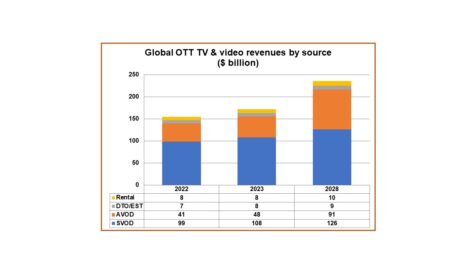
After more than 40 years of operation, DTVE is closing its doors and our website will no longer be updated daily. Thank you for all of your support.
Cloud transformation gathers pace
 Cloud is attractive to service providers – in theory. But big challenges stand in the way of realising the virtual operator, reports Adrian Pennington
Cloud is attractive to service providers – in theory. But big challenges stand in the way of realising the virtual operator, reports Adrian Pennington
All elements of the video distribution chain have been enhanced through the evolution of cloud technology, ranging from creative tools that utilise cloud-based applications, through to content encoding, packaging and distribution. Cloud as a technology has matured; cloud networks have become media friendly, Open Source tools are reliable, and the hybrid cloud market is expanding rapidly.
And yet challenges remain. A chief one is cost, where operational expenditure is not as transparent as it might be. The speed of implementation (and associated opportunity cost) remain an issue for some, and the application and business suitability of the native benefits of cloud must be weighed versus on-premises facilities.
Put simply, there is no ‘one-size-fits-all’ approach to migrating to cloud-native environments and it can be a complex process to navigate.
“We are seeing the effects of cloud-led innovation across the entire media chain, ranging from new developments in contribution and distribution, through to delivering more flexible methods of delivery and enabling more personalised consumption experiences,” says Stuart Boorn, VP, product management at MediaKind. “The video distribution chain has also adapted to cloud by updating many standards to align with IT and cloud practices.”
That’s a widely accepted view with which vendors and operators can concur. Verizon Media’s chief product officer for its media platform, Ariff Sidi, says media companies and service providers are “fully embracing digital transformation” in order to stay competitive and meet consumer expectations, and cloud adoption is a big part of this.
Everything cloud
“Initially, cloud capabilities were used for specific point solutions,” Sidi says. “But, as cloud capabilities have expanded, what can be done has grown to encompass multiple use cases, and has made it possible to manage the entire delivery workflow end-to-end, providing nearly everything providers need to engage with new customers and grow revenue.”
Ralf Hülsmann, head of partner ecosystems of Deutsche Telekom subsidiary T-Systems’ public cloud unit believes that “all elements of the production chain today” can be served directly from the cloud.
“Solutions are available for each step, from virtual mixer to postproduction to playout. It depends, however, on the technology maturity, processes and collaboration methods used by the individual company.”
Live video requires the ability to scale resources flexibly and quickly, making this a great application of cloud infrastructure.
Ariff Sidi, Verizon
Migration also depends on application, some of which are more naturally suited to cloud usage than others. “Live video with high concurrency viewership requires the ability to scale resources flexibly and quickly, making this a great application of cloud infrastructure,” says Sidi. “However, encoding of VOD assets tend to be less time- and scale-critical and therefore this application could be a good candidate for on-premises infrastructure.”
Ease of scaling resources, for example, for a major sporting event like the Super Bowl, is a powerful characteristic of cloud infrastructure and one of the most frequently used ways for providers to improve the reliability and quality of their distribution.
“Delivering new services at internet speed remains the challenge that traditional operators must overcome to compete with SVOD services,” says Boorn. “Cloud technology enables users to scale up or down a line-up of channels or services in a matter of seconds, and faster than any conventional hardware-based approach. It makes sense for service providers to virtualise the management of their linear, VOD or live and pop up channels via a cloud platform as it allows them to manage their resources with greater agility. Operating via the cloud enables service providers to rapidly switch interfaces and deliver immersive, high-value content more cost effectively.”
As an example, by optimising and scaling video head ends within the cloud, it is possible for broadcasters to unify UHD, HD and SD video processing. This can lower latency and enable content to be delivered across multiple networks.
“Delivering live streams to multiple devices and platforms and in regions with different bandwidth constraints and no one codec is appropriate for every single scenario,” claims Stefan Lederer, CEO and co-founder, Bitmovin.
“Therefore, video developer teams need to have access to a range of the most up-to-date codecs so they can use the more effective one for a particular situation. Whereas traditional hardware can often be using older codecs, cloud-based encoding technologies have the capability to adopt and support new and existing media codecs to ensure that live video and VOD matches, or even surpasses, the quality of linear TV.”
Disaster recovery is another effective use of cloud infrastructure, whether that means protection against failures from other cloud zones or regions, or from failures of on-premises infrastructure.
“SaaS is a perfect fit for disaster recovery, as it enables you to deploy disaster recovery very rapidly in order to address unpredictable situations,” says Thierry Fautier, VP of video strategy at Harmonic.
A transmission outage such as a cyber attack on France’s TV5 Monde in 2015 would have been prevented “easily and cost effectively by cloud technology,” says Hülsmann. “Most cloud providers offer high security at low costs.”
Hybrid (cloud/on-premises) scenarios for automated metadata generation and long-term archiving are topics of great interest among operators. Other applications include digital ad insertion “thanks to SaaS business models that can scale with the number of sessions, enabling operators to support millions of concurrent subscribers,” says Fautier, and pop-up channels used to broadcast major sports events.
“In these scenarios, having a scalable solution is a significant benefit,” Fautier says. “A great example is Telkomsel with its MAXStream service ramping up support for four million subscribers in 30 days during the FIFA 2019 World Cup.”
For service providers whose offerings are of the more pop-up variety or which change frequently then having the whole workflow in the cloud may well be more economically viable, but perhaps the biggest piece of the transmission chain yet to wholeheartedly embrace the cloud is playout.
“For live video workflows that are active 24/7 and run at a consistent level, it is hard to beat the TCO of a dedicated on-prem data centre,” says Nick Fielibert, CTO, Video Networks, Synamedia. “As live TV comes with services like restart, catch-up and cloud DVR it requires a lot of egress bandwidth from the data centre to the subscriber, which may make public cloud costs prohibitive. Ingest in the public cloud is growing in popularity but can sometimes be a challenge for non-compressed video because of the bandwidth requirements. Though cloud servers are increasingly able to handle higher throughputs, getting Gigabits per second of uncompressed data processed without any packet drops is still pushing the boundaries, technically speaking.”
Cloud cost challenges
Distribution is all about caching content as close as possible to the subscriber. “Right now, cloud locations are not always close enough to the broadband aggregation points, giving private CDNs an advantage over public ones,” says Fielibert. “However, some cloud providers are overcoming this by building their own widely distributed CDNs.”
Hülsmann also finds moving traditional linear TV to the cloud “cumbersome” for both change and cost reasons. “What is needed in playout scenarios is a broad low-latency network access to the consumer – which we support natively,” he adds.
Sidi agrees that ingest to the cloud can be a challenge “when a service provider needs to obtain a high bitrate and high resolution contribution feed from a content provider who may be generating that feed on the other side of the planet.” Verizon Media says it deals with this challenge often and so is “quite experienced with it…but it is not a trivial problem.”
Additionally, cloud capabilities and the flexibility they provide come with a cost profile that is different than using proprietary on-premises solutions.
“How those cloud costs compound over time compared to the costs of running one’s own infrastructure is an analysis that providers should undertake to ensure they get the most benefit from cloud adoption with the most efficient use of capital,” says Sidi. “Depending on the use-case, moving infrastructure from on-premises to the cloud may result in migrating costs that may decrease over time to costs that remain flat.”
Reliability and security are not considered an issue for cloud-based services using carrier-grade infrastructure. “Service providers can create resilient video workflows by making use of cloud providers’ geo-redundant data centre infrastructure and deployment zone systems,” says Fielibert.
Cost can be an issue, though, for public cloud – and may render a pure public cloud deployment uneconomical. Fielibert points to a hybrid model, where service providers blend the flexibility of the cloud with the cost benefits of an on-prem deployment, as a possible cost-effective alternative.
“Disaster recovery is a good example: a service provider can run the media processing backup workflows for a premium channel on-premises for high availability, and have the ability to quickly launch these workflows in the public cloud in case of a disaster.”
Fautier concurs that cost is an important factor, but warns that it’s dangerous to compare the cost of cloud with a dedicated on-premises appliances.
“On-premises appliances do not offer the same functionality with regards to flexibility, instant scalability and time to market,” he argues. “Time to repair is an important metric that is often forgotten. In a classical appliance approach, time to repair is counted in matters of weeks compared with a matter of hours for cloud deployments.”
Cloud-based video processing gives providers the power to orchestrate, manage and monitor their whole infrastructure.
Stefan Lederer, Bitmovin
One of the biggest priorities for service providers is making sure that their content remains, particularly for high-value live and VOD content, which according to Lederer has made some media and entertainment brands reluctant to migrate video processing to the cloud.
“Bitmovin has worked around this issue by developing on-premise encoding service that works with both live video and VOD,” he explains. “The encoding service can be run locally on hardware whilst still enabling customers to use cloud encoding power, speed and flexibility. Content service providers are already aware that the cloud is more cost-effective and flexible compared to purpose-built hardware, and we have also found a way to ensure security without compromising on power.”
Migration at your pace
There is more than one way to migrate to cloud-based operations and services. As an initial option or trial run, operators and service providers could consider simple systems that reduce the cost and production activities of breakthrough services that entice new subscribers. However, according to Boorn, the media industry needs to build a consensus around all-IP standards and specifications.
“Retaining the ‘network effect’ of interconnected, best-of-breed devices, will be crucial for the industry and will ensure that it avoids denigrating the quality of experience it has enabled for decades,” he insists.
Traditional broadcasters and operators have an enormous amount of legacy technology which makes any refresh an enormous investment. All will be eyeing the best means to bridge the world between these legacy and cloud-enabled environments, believing that this will involve investing more in opex and less in capex over time.
“While many early adopters have moved to the cloud to deliver OTT services, we are now seeing public clouds being increasingly adopted for more workloads,” Boorn says. “Protecting access, data and communications requires new skills and knowledge to keep services up to date, especially while using a public cloud, meaning that the correctly skilled personnel are as important as decisions taken over which technology to use.”
Phased approaches will minimise risk and maximise learning. “Public cloud works for adding levels of redundancy, where workflows are duplicated on a private and public cloud,” says Fielibert. “Launching new services from the cloud is a good way to test the waters because new services can be spun up quickly and cost effectively. In parallel, the service provider can acquire the resources necessary to move these workflows to the on-premises data centre over time.”
It’s an approach advocated by Verizon Media and T-Systems, says Hülsmann: “Obviously, it is easy to turn things on and off in the cloud without additional investments while at the same time you keep your applications in a totally isolated environment. In addition, most new software comes in containers – for example, artificial intelligence modules face detection as well as encoding and quality checks. That is perfect for cloud deployments, whereas setting up a technology like Kubernetes on your own premises is somewhat painful. If you move on from proof of concept to pilot project and finally to production, the cloud is a best fit for scalability.”
Sidi adds: “When considering whether or not to utilise the cloud, it makes sense to identify small use-cases that can be well-defined and put a plan in place to migrate or build that capability in the cloud,” advises Sidi. “This allows the company to limit their exposure while learning how to operate a cloud-first technology stack.”
Verizon Media is a heavy user of the cloud, but also maintains significant on-premises capabilities. Sidi says the company has become “very good” at operating technology in both environments, “but we still consider the trade-offs, costs, risks and opportunities each time”.
He says: “When investing in on-premises infrastructure, it’s important to consider the long-term needs and how that infrastructure may need to grow – or not – over time.
Growing the footprint of on-prem infrastructure can become very expensive, maintaining the facilities to house it can also be expensive, maintaining resources to maintain the facilities are yet another cost, as is building the software capabilities that may be available natively on the cloud. However, if these are fixed costs that decrease over time, it may be economically sound to go on-premises. And if physical security is paramount, it may be required.
“Alternatively, cloud technology removes a lot of the overhead of building software systems. It provides a natural path to scale and a slew of capabilities right out of the box that can be utilised quickly. And, as we know, speed is often the priority.”
Lederer argues that content providers need to consider the cost effectiveness of investing in on-premises infrastructure that doesn’t use the cloud, as it will inevitably be more expensive and not as future proofed.
“Cloud-based video processing provides content service providers with the power to orchestrate, manage and monitor their whole infrastructure all in one place,” he says. “On-premises cloud-encoding technologies offer the benefit of a SaaS solution, while running seamlessly on hardware infrastructure. Ultimately, in today’s ever-evolving media landscape, the companies that will remain competitive are the ones that invest in technology that is versatile and can be quickly adapted to changing market conditions. We believe that cloud solutions that will be the fundamental differentiator for market leaders, when compared with those companies doggedly sticking to hardware-based encoding technologies.”
In summary, service providers will need to weigh up the relative importance of cost, flexibility, future proofing and reliability when making a decision. Generally speaking, pure live and derived services like time-shifted TV that are static in time will have a lower total cost of ownership when deployed in an on-prem data centre, whereas VOD, pop-up channels and disaster recovery may be better suited to the cloud at this stage.
5G video and the cloud
IHS Markit research is predicting that the 5G era is set to drive the next wave of growth in video streaming, with the deployment of 5G causing video usage to grow to account for 70% of mobile network traffic in 2022, up from 47% in 2015.
This shift to mobile streaming presents huge opportunities on a global scale, but the competition is fierce with new players entering the market to offer content direct to consumers who won’t tolerate buffering or lag.
“5G is just being rolled out, however, the video services experimented on 5G are also new,” says Thierry Fautier, VP of video strategy at Harmonic. “We are talking about streaming higher resolution video, i.e., 8K, to mobile devices. This was recently demonstrated by Harmonic and its partners at the 2019 French Tennis Open using classical streaming as well as tiling technology to address legacy devices. These state-of-the-art services offer fans a multi-view of live sports, which fits well with 5G as it offers much more bandwidth than in the case of 4G. Many of the applications for 5G will be related to sports events. Other use cases will be more experimental; therefore, cloud is the best fit to support those new applications.”
One of the reasons the traditional platforms have survived is because they just work – the content is available, instantly, at the press of a button. That isn’t always the case with streaming. It doesn’t matter how visually engaging the user interface is or how many features it offers, the biggest impact on user experience (positive or negative) is the reliability and immediacy of content delivery.
In terms of reliability, high bandwidth fibre is increasingly available at venues and more content is being uploaded over 4G and 5G networks. Distribution over IP or direct to consumer via a cloud platform ensures content reaches audiences quickly on their chosen devices.
“With the advent of 5G networks and the growth in mobile video globally, an increasing number of contribution networks are becoming cloud uplinks, while the burgeoning popularity of IPTV services are cloud downlinks,” says Stuart Boorn, VP, product management, MediaKind . “Cloud based platforms offer the perfect opportunity to test new product areas.”


